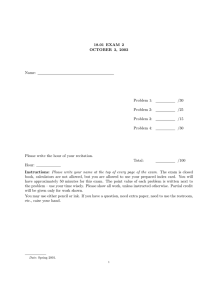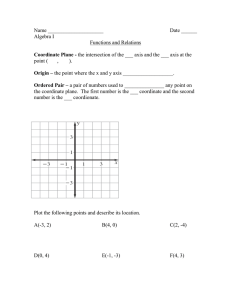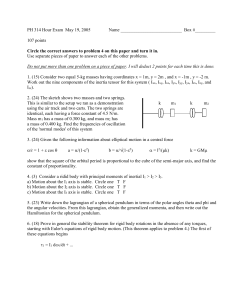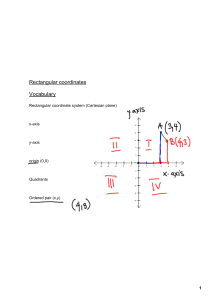NOTE ON DETERMINATION OF OPTIC AXIAL ANGLE AND
advertisement
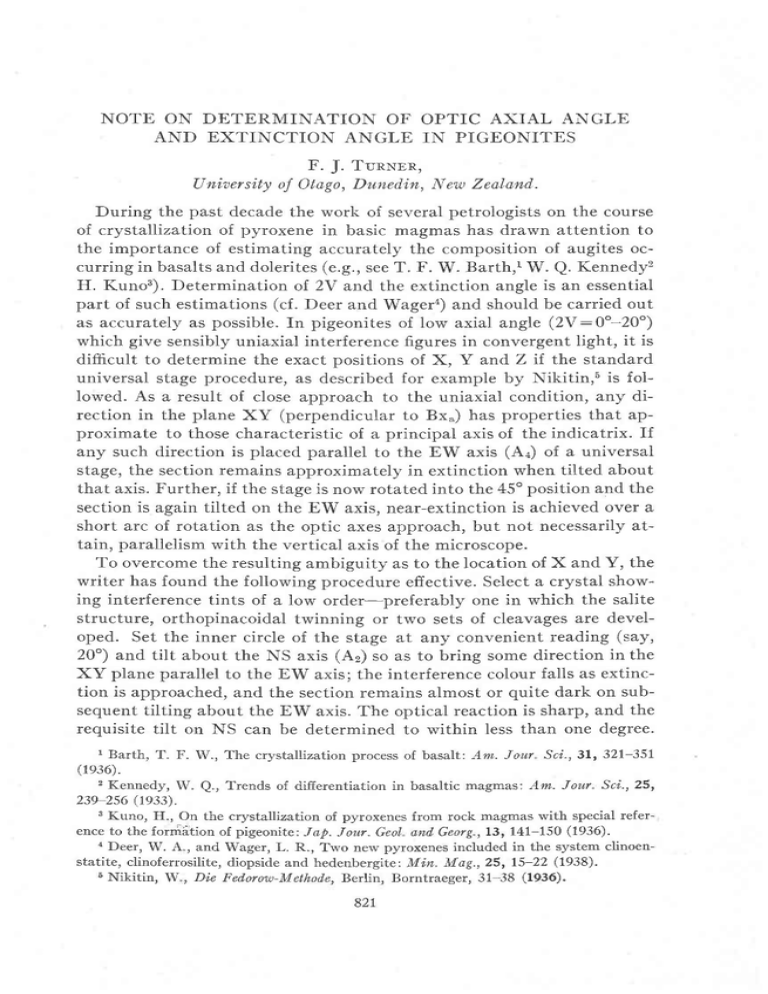
NOTE ON DETERMINATION
OF OPTIC AXIAL ANGLE
AND EXTINCTION ANGLE IN PIGEONITES
F. J. TunNrn,
[Jniters'ity oJ Otago,Dunedin, I{ew Zealond.
During the past decade the work of several petrologists on the course
of crystallization of pyroxene in basic magmas has drawn attention to
the importance of estimating accurately the composition of augites occurring in basaltsand dolerites(e.g.,seeT. F. W. Barth,r W. Q. Kennedy2
H. Kuno3). Determination of 2V and the extinction angle is an essential
part of such estimations (cf. Deer and Wagera)and should be carried out
as accurately as possible.In pigeonitesof low axial angle (2V:0"-20")
which give sensibly uniaxial interference figures in convergent light, it is
difficult to determine the exact positions of X, Y and Z if. the standard
universal stage procedure, as described for example by Nikitin,5 is followed. As a result of close approach to the uniaxial condition, any di
rection in the plane XY (perpendicular to Bx.) has properties that approximate to those characteristic of a principal axis of the indicatrix. If
any such direction is placed parallel to the EW axis (Aa) of a universal
stage, the section remains approximately in extinction when tilted about
that axis. Further, if the stageis now rotated into the 45oposition and the
section is again tilted on the EW axis, near-extinction is achieved over a
short arc of rotation as the optic axes approach, but not necessarilyattain, parallelism with the vertical axis of the microscope.
To overcome the resulting ambiguity as to the location of X and Y, the
writer has found the following procedure efiective. Select a crystal showing interference tints of a low order-preferably one in which the salite
structure, orthopinacoidal twinning or two sets of cleavagesare developed. Set the inner circle of the stage at any convenient reading (say,
20") and tilt about the NS axis (A2) so as to bring some direction in the
XY plane parallel to the EW axis; the interference colour falls as extinction is approached,and the section remains almost or quite dark on subsequenttilting about the EW axis. The optical reaction is sharp, and the
requisite tilt on NS can be determined to within less than one degree.
l Barth, T. F. W., The crystallization process of basalt: Am. Jour Sci.,31, 321-35I
(1936).
2 Kennedy, W.
Q., Trends of difierentiation in basaltic magmas: Am. Jour Sci.,25,
2s9 2561933).
3 Kuno, H., On the crystallization of pyroxenes from rock magmas with special refere n c e t o t h e f o r m i t i o n o f p i g e o n i t e :f a p . I o u r . G e o l a n d , G e o r g , L 3 , 1 4 1 - 1 5 0 ( 1 9 3 6 ) .
a Deer, W. A and Wager, L. R., Two new pyroxenes included in the system clinoen,
statite, clinoferrosilite, diopside and hedenbergite: Min. Mag.,25, 15-22 (1938).
6 Nikitin, W Die Fedorow-Method.e,Berlln, Borntraeger, 31-38 (1936).
,
821
822
F, J. TURNER
Now rotate on the inner vertical axis through successiveintervals of 20o
or 30o and repeat the above procedure for each position of the section,
provided that the tilt on the EW axis does not exceed about 35o. The
points so obtained (poles of lines in the plane XY) are now plotted on a
stereographic net,6 preferably using the lower hemisphere of projection,
and they will be found to lie on a great circle of the net (AA in Fig. 1).
If any point departs from the circle, the discrepancy is due to error in
measurement,and the correspondingaxis should be measured again. The
acute bisectrix Z is perpendicular to the great circle so determined and
can now be plotted. The writer finds that Z canbe located more accurately by this method than by direct measurement, especially since in sections suitable for measuring 2Y the direct method must involve high
angles of tilt on the NS axis.
Frc. 1. Stereographic projection(Iowerhemisphere) oI twinned pigeonitefrom diabase,
West Rock, New Haven, Connecticut. Solid circles:observed points; open circles:deduced points; crosses adjacent to Z1:el5s1yed points of emergence of optic axes in the
first half of the twinned crystal.
The positions of X and Y have now to be determined. One of these directions is perpenciicularto (010), while the other is parallel to (010), so
that if this latter plane is located and plotted its intersection with the
plane XY will be either X or Y, usually the former. To do this it is necessary to measure either (a) the basal plane as indicated by salite structure, or (b) the twinning-plane (100) and corresponding twinning axis c
in orthopinacoidal twins, or (c) the intersection of two sets of prismatic
cleavages.
(a) If salite structure is present, as is commonly the casewith pigeonite in dolerites, the position of (001) can be observed directly, usually
6 A Schmidt equal-area net
will do equally well.
OPTIC AXIAL ANGLE OF PIGEONITES
823
with great accuracy on account of the sharp definition of the planes of
parting involved. Its pole is plotted on the projection and the great circle
(010) is drawn through this pole and the pole of Z.
(b) When the crystal shows orthopinacoidal twinning, the position of
Z is determined in both halves of the crystal, and the twinning plane
(100) is observeddirectly. The poles ol21, 22 and (100) should lie on the
great circle (010). This is probably the most accurateof the three methods.
(c) The prismatic cleavagesare usually less sharply defined than the
basal parting, and their positions can therefore be determined only to
within one or two degrees.Their intersection on the projection gives the
position of the c axis to within about 3", and the great circle through this
point and Z is (010).
On the great circle perpendiculartoZthe poles of X and Ylie at the
intersection with (010) and the point 90o distant from this. By rotation
on the inner circle and tilting about the NS axis of the stage, bring one of
these axes parallel to the EW axis. Rotate the whole stage into the 45o
position using the vertical microscope axis, then tilt to extinction (or
near-extinction) on the EW axis. If the crystal axis in question is X, a
narrow zone of near-extinction is attained as the acute bisectrix Z is
brought parallel to the microscopeaxis. If the crystal axis is Y, then extinction prevails over a wider arc of tilting as first one optic axis and then
the other is brought parallel to the vertical axis of the microscope.fn this
case the axial angle 2V can be measured directly. If the value of 2V is
greater than about 10o a zone of very faint illumination can usually be
distinguished between the axial points, but for smaller values of 2V there
is darkness over the whole arc between the optic axes.
The extinction angle Z/\c may be determined by direct measurement
from the projection (seeFig. 1):
(a) Where (001) has been plotted, ZAc: the angle betweenZ and the
pole of (001) plus 16o(sincein augitesthe crystallographica\gle p:74a).
(b) In twinned crystals the bisectors of the angles between Zr and.Zz
are the c axis and the normal to (100), respectively. The extinction angle
ZAc is thus one-halfthe appropriate angleZrAZz (cf. T. NemotoT).This
is probably the most accuratemethod of determiningZ\c.
(c) If no crystals showing salite structure or twinning are available,
Z\c is best determined in a section approximately parallel to the plane
(010). Here the position of Zis measureddirectly and c is given by the
trace of the vertical cleavages.
7 Nemoto, T., A new method
of obtaining extinction angle of monoclinic minerals,
especially of pyroxenes and amphiboles, by means of random sections: Jour. Fac. sci.
Hokkaid.oImp. Univ., (4), 4, 107-111 (1938).
F. J. TURNER
824
In order to obtain the composition of the pigeonite under consideration
it is of course still necessaryto determine either refractive indices or birefringence.
As an example, measured data are given for a twinned crystal of
pigeonite in diabase from West Rock, New lfaven, Conn., in which
pigeonite is associated with a normal augite having 2Y :42"-56'. The
readings cited are those for which the measured direction or plane is
parallel to the EW axis of the stage;if the measuredelement is a plane it
is also parallel to the vertical axis of the microscope.Tilts on the NS axis
from the right-hand side are recorded thus <-; tilts on the EW axis away
from the observer are indicated thus t
Reading on
Inner Circle
8'
First half of
crystal.
J('
90
130
34
Twinning-plane(100).
Cleavage(110).
IU
20
10
0
350
274
70
35'+
224+
28?
0
0
2 2 "I ( + 3 )
8J (+3)
38+
18r
13e
36+
18+
0
8l (A3)
From the projection based on these data (Fig. 1) the positions of various crystallographic directions may be read as follows:-
Crystallographic
Direction
b (:Xr
c
Yr
Yz
Zt
Zz
and Xz)
Reader on
lnner Circle
18'
58
27e+
341
354
Extinction angle Z \c : 40".
Optic axial plane transverseto (010).
OPTIC AXIAL ANGLE OF PIGEONITES
825
2V (measuredwith Yl parallel to the EW axis of the stage):14" (+2).
Applying these data to the diagram of Deer and Wager,8 two alternative compositions are possible for the pyroxene in question, viz., Wo6
Ens6Fsaa,or Wo1eEn67Fszs.
The birefringence (f**) determined with a
Berek compensator,assuming birefringence of 0.007 for an adjacent
crystal of labradotite (An57), is 0.026. This favors the composition
WoeEnsoFs+1.
The accuracy of the data obtained in the above-describedinvestigation
can be checked to some extent by plotting the observedcleavagesparallel
to (110).The angle betweenthe pole of (110) and D should be 43o35';thar
between the pole of (110) and c should be79"10'; the angle measuredon
the projection between D and the pole of the observedcleavage(110) is
actually 43", though the latter departs slightly from the great circle perpendicular to c.
As a further check on the position of the axial plane, 7-B was determined with a Berek compensator as .0245, as compared with 7-a
:.026. This correspondsto 2V:about 22o,using the Boldyrew chart
as given by Nikitin.e
The same procedure on a second twinned crystal gave the following
results: 2V:20"; axial plane perpendicular to (010)i ZAc:39"; 7-a
: .027.
8 Loc.cit
, 2 2 , N ' i g .3 .
s Loc. cit., pl. IV.
